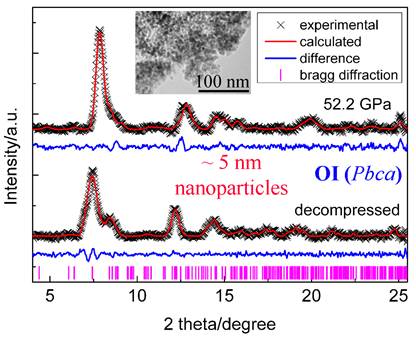| Nanosize effects assisted synthesis of the high pressure metastable phase in ZrO2 |
| From: PublishDate:2017-06-16 Hits: |
ZrO2 is a hard material with excellent mechanical properties, which has been widely applied in the fields of electronic device, aeronautical and space, medical apparatus, and so on. ZrO2 has monoclinic (MI) structure under ambient conditions, whereas, has two orthorhombic (OI and OII) structures under high pressure. These high pressure phases are potential novel hard materials, which possess lower compressibility. However, the OI phase is hard to remain at ambient conditions, which has more excellent mechanical properties predicted by theoretical calculation. How to obtain the stable OI phase under ambient pressure is still a challenge. A team from state key laboratory of superhard materials of Jilin university has successfully synthesized stable OI ZrO2 nanoparticles under ambient conditions combining nanosize effects and high pressure method. Their research has been published in Nanoscale in 2016. The team found that ZrO2 nanoparticles with different sizes shown distinct phase transition process under high pressure. The coarser nanocrystals with size of 100-300 nm exhibited the same high pressure phase transition sequence (MI-OI-OII) as their bulks. However, only MI-OI phase transition occurred in the ~5 nm ultrafine nanocrystals, the OI-OII transition was precluded. Upon decompression, coarser and ultrafine nanoparticles remain OII and OI phases at ambient conditions, respectively. The nanosize effects can effectively modify the high pressure structural phase transitions, which improve the structural stability and preclude the formation of high pressure OI phase. Pure OI phase ZrO2 was synthesized for the first time.
XRD patterns of ~5 nm ZrO2 nanoparticles with OI phase at different pressures. The inset is the TEM image of the pristine samples. The structural transition behaviors of ZrO2 nanoparticles with different sizes were studied by using the X-ray diffraction (XRD) and X-ray absorption fine structure spectroscopy (XAFS) of Beijing Synchrotron Radiation Facility (BSRF). It was found that the high pressure phase transition sequence can be modified by the nanosize effects. The high pressure metastable OI phase ultrafine nanoparticles with size of ~5 nm were successfully synthesized. They suggested that the high surface energy of the ultrafine nanoparticles leads to the significantly enhanced energy barrier of OI-OII phase transition and precludes the formation of the OII phase. The ultrafine MI phase nanoparticles show higher bulk modulus than that of the coaser nanoparticles. These results indicated that increasing the size of materials would be helpful for improving their mechanical properties. The research provides the scientific evidence for understanding the unique phase transition behaviors and novel physical properties of nanomaterials. In this study, synchrotron sources have helped the team to perform the in situ study of the structural evolution of ZrO2 nanoparticles under high pressure. "Some new structure and properties can be obtained in nanoscale, which is difficult to achieve in the corresponding bulks. Therefore, nanoscale provides a new method for exploring novel functional materials" explains Bingbing Liu, the team leader and the professor of State Key Laboratory of Superhard Materials, Jilin University. Article: Quanjun Li, Huafang Zhang, Ran Liu, Bo Liu, Dongmei Li, Lirong Zheng, Jing Liu, Bo Zou, Tian Cui, and Bingbing Liu*, Nanosize effects on the high pressure phase transitions of ZrO2, Nanoscale, 8 (2016), 2412-2417. |
|
|
| Chinese
- Metal-free efficient photocatalyst for stable visible water splitting——Top ten major scientific progresses in China in 2015
- The nano-resolution imaging platform was awarded the first rate prize of Beijing Science and Technology in 2014
- Beamline 1W1 of BSRF started to runoperate in the couplingparasitic mode of BEPCII
- Synthesis of High Performance Polymer Materials for Field Effect-Transistors
- Surfactant molecular aggregates in green solvents
- GIXRD has played an important role in the characterization of organic thin-film transistors
Science Highlights
Home /
Copyright © 2011 - 2012 Beijing Synchrotron Radiation Facility


